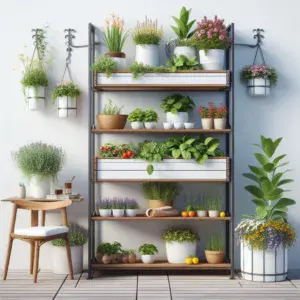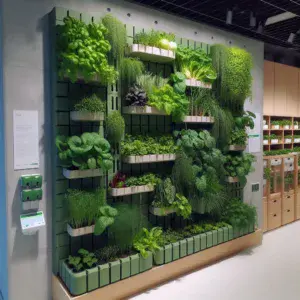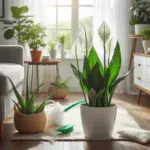
Vertical gardening is a fantastic way to add greenery to your home without using up valuable space. Urban dwellers and small homeowners find the idea of growing upwards instead of outwards very appealing. Imagine having herbs, veggies, and flowers all reaching toward the sky—with easy access at all times! This method cleverly uses walls, trellises, or standalone frames to create a green oasis that defies traditional gardening. 🌿
One of the biggest wins of vertical gardening is how it maximizes space. You can grow a variety of plants even in tight spots like balconies or small backyards. Plus, vertical gardens can act as natural air filters while sprucing up plain walls. Win-win!
So, why all the buzz about vertical gardening? Because it’s not just about looks. This method is a top choice for urban gardeners who want fresh produce but lack the room for classic rows of vegetables. Plus, harvesting becomes quicker and less back-breaking when plants are closer to eye level.
With minimal ground area required, vertical gardening transforms small spaces—and how we think about gardening altogether.
Techniques of Vertical Gardening: From Choice to Execution 🌱
There are several techniques for vertical gardening, each offering a unique approach for your green thumb adventure. Whether you’re a beginner or a seasoned gardener, there’s always something new to try.
Pocket Planters
Pocket planters hung on walls are a simple and beginner-friendly option. Fabric pockets filled with soil are perfect for herbs and lettuces and can easily fit into kitchen spaces for convenience.
Trellises
A classic vertical gardening technique, trellises support climbing plants like beans, cucumbers, or tomatoes. They help plants stand tall and double as decorative features, creating green curtains that can also offer shade.
Living Walls
Living walls—or green walls—use modular panels to support a large number of plants, often with built-in irrigation systems. Though more advanced, they offer impressive yields and can transform both indoor and outdoor spaces.
Modular Towers
Towers or modular systems feature multiple planting layers. Pot towers let you stack pots vertically, allowing you to manage different soil needs while maximizing small areas.
What Plants Grow Best in a Vertical Garden? 🍅
Lightweight, climbing plants usually perform best in vertical setups.
Here are some favorites:
- Lettuce and spinach for pocket systems
- Tomatoes, beans, and peas for trellises
- Strawberries in hanging pockets
- Herbs like basil, oregano, and thyme
Heavier crops like squash or melons need reinforced supports but can still thrive vertically if properly planned.Tip: Choosing the right technique based on your plant type is critical for maximizing your yield!
Here is a Space Saving, Lightweight and Durable option from Gardeners Supply Company.
Maximizing Yield in Vertical Gardens: Tips and Tricks 🌞

Getting the most out of your vertical garden requires a few smart strategies:
Optimize Light Exposure
Position your vertical garden where it gets maximum sunlight. Adjust the layout during the year as the sun’s angle changes. LED grow lights on timers can also supplement light in tricky spots.
Efficient Watering
Drip irrigation systems deliver water directly to the roots, minimizing waste. Consider adding hydrogels to the soil to retain moisture longer without frequent watering.
Feed Your Plants
Use slow-release fertilizers or organic compost to keep your plants healthy. Vertical gardens often have less soil volume, so nutrients deplete faster. Top Fertilizers for Urban Gardens
Smart Companion Planting
Pair plants that benefit each other.
Example: Tomatoes and basil grow well together, boosting flavor and deterring pests naturally.
Proper Plant Spacing
Avoid crowding your plants. Think about their mature size and root spread. Balanced spacing ensures better airflow, stronger growth, and fewer disease problems.
Monitor the Microclimate
Watch for drafty spots or excessive heat areas. Adjust your setup to create a stable environment for plant health. Whether it’s a shift in planting position or adding windbreaks, small tweaks can have a big impact.
FAQ: Vertical Gardening Tips 🌱
The best plants for vertical gardening are lightweight climbers and compact growers. Great choices include lettuce, spinach, strawberries, tomatoes, peas, herbs like basil and oregano, and pole beans. Heavier plants like squash or melons can work too with strong support.
It can be affordable or expensive depending on your setup. Basic vertical gardens using DIY materials like pallets or pocket planters are budget-friendly. More advanced living wall systems with automated irrigation can cost more, but careful planning keeps it manageable.
Drip irrigation is one of the most efficient methods for watering vertical gardens. It delivers water directly to the roots, reducing waste and preventing overwatering. You can also mix hydrogels in the soil to help retain moisture longer.
Absolutely! Indoor vertical gardens thrive with good light. Choose a sunny window or add LED grow lights to supplement natural light. Pocket systems, small trellises, and modular towers all work well inside homes or apartments.
Maximize yield by optimizing sunlight, watering properly, using rich soil, practicing companion planting, and spacing plants correctly. Regularly feeding your plants with compost or fertilizer also boosts productivity in vertical gardens.
Potential Drawbacks of Vertical Gardening 🌦️
While vertical gardening is rewarding, it’s important to know the challenges:
- Water Management:
Watering can be uneven—some plants may get flooded while others dry out. Drip systems help, but you’ll need to monitor closely. How To Save Water While Gardening In The City - Structural Concerns:
Ensure your wall or frame can handle the weight of mature plants, especially if growing heavier crops. - Costs:
Initial setup costs can add up, especially with frames, pocket planters, and automated systems. - Environmental Impact:
Choose sustainable and recycled materials whenever possible to minimize your garden’s footprint.
These aren’t deal-breakers—just factors to plan for!
Advanced Vertical Gardening Tips for Serious Growers 🌿
Want to level up your garden? Try these advanced tactics:
Install Automated Drip Systems
Save water, time, and hassle with a timed irrigation setup that waters your plants exactly when needed.
Use Technology
Garden apps and moisture sensors help monitor light, water, and plant health, offering precision data to optimize your results.
Natural Pest Barriers
Use netting, companion planting, and natural repellents to protect your vertical garden without chemicals.
Disease Prevention
Regular inspections for signs of stress or disease can stop issues before they spread. A healthy vertical garden is a high-yield garden!
Maximize Every Inch
Mix plant types vertically—grow leafy greens alongside root crops—and use unconventional containers like shoe organizers, gutters, or upcycled pallets.
Happy Gardening! 🌱
Vertical gardening isn’t just about saving space—it’s about creating vibrant, productive gardens anywhere. With a little planning and creativity, you can grow an amazing harvest right at your fingertips. 🌿




